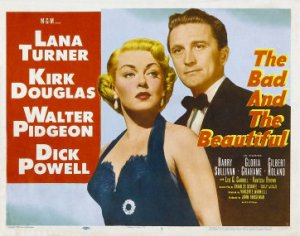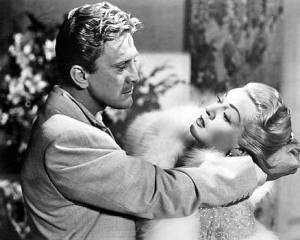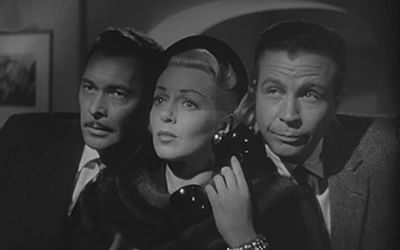 Some films garner enough praise (or controversy) to keep them famous for decades – Citizen Kane a case in point. Others, including some truly extraordinary works, are inexplicably forgotten by all but the die-hard fans and classic cinema buffs. The Bad and the Beautiful is one of these.
Some films garner enough praise (or controversy) to keep them famous for decades – Citizen Kane a case in point. Others, including some truly extraordinary works, are inexplicably forgotten by all but the die-hard fans and classic cinema buffs. The Bad and the Beautiful is one of these.
Made in 1952 by Vincente Minnelli, the film’s working title was “Tribute to a Bad Man”. Told in flashback, it is three people’s stories of one man: producer Jonathan Shield (Kirk Douglas). Jonathan is an ambitious, hungry filmmaker determined to make a name for himself. In climbing this lofty ladder, he tends to stand on the shoulders (not to mention toes) of other talents, in particular actress Gloria Lorrison (Lana Turner, the “Beautiful” half of the film’s ultimate release title), director Fred Amiel (Barry Sullivan) and writer James Lee Bartlow (Dick Powell).
The film opens with each of the three declining to speak to Shield, before making their way to meet with Harry Pebbel (Walter Pidgeon), the former B-movie producer who, along with Shield himself, was instrumental in kick-starting each of their careers. Harry wants them, all now major stars in their own right, to make one more picture with Jonathan Shield, whose career has faltered. They refuse.
Each of them then tells their story: Fred formed a partnership with Jonathan when they were both starting out in the film business, only to have his “baby”, a script he’d worked on for years, stolen from under him by the man he trusted above all others. Gloria was an alcoholic nobody, picked up by Jonathan and made a star; when she fell in love with him, he betrayed her. James Lee was a professor with a best-selling novel who came reluctantly to Hollywood to write a screenplay. When Jonathan felt Bartlow’s beloved wife Rosemary (Gloria Grahame) was getting in the way, he arranged for her to spend the day with a movie star; their plane crashed, killing her.
 Like many great Hollywood films about Hollywood – Singin’ in the Rain and The Player, for example – The Bad and the Beautiful represents both a love poem to the industry and a critique of the harsher, crueller aspects of the business. The casting is excellent. Kirk Douglas, with his expansive charm and clenched jaw, is marvellous as the charismatic and ambitious Jonathan, and Lana Turner (a big enough star to get the film’s top billing) evolves perfectly from the frightened, hard-drinking child of the early scenes into the poised, elegant star she becomes. The smaller roles – Sullivan, Powell, Grahame and Pidgeon – are just as well cast and performed.
Like many great Hollywood films about Hollywood – Singin’ in the Rain and The Player, for example – The Bad and the Beautiful represents both a love poem to the industry and a critique of the harsher, crueller aspects of the business. The casting is excellent. Kirk Douglas, with his expansive charm and clenched jaw, is marvellous as the charismatic and ambitious Jonathan, and Lana Turner (a big enough star to get the film’s top billing) evolves perfectly from the frightened, hard-drinking child of the early scenes into the poised, elegant star she becomes. The smaller roles – Sullivan, Powell, Grahame and Pidgeon – are just as well cast and performed.
The film’s best moments occur when the mechanics and thought processes of film production are revealed: perhaps the finest scene of all takes place when Fred and Jonathan are attempting to make a decent film of the last B-feature project given them by Harry. After a disastrous costume fitting in which all the actors look like cheap children’s party entertainers instead of the terrifying Cat-men they are supposed to be, the following exchange takes place:
Jonathan: Look. Put five men dressed like cats on the screen, what do they look like?
Fred: Like five men dressed like cats.
Jonathan: When an audience pays to see a picture like this, what are they paying for?
Fred: To get the pants scared off of ’em.
Jonathan: And what scares the human race more than any other single thing?
[crosses to wall switch and turns out the light]
Fred: The dark!
Jonathan: Of course. And why? Because the dark has a life of its own. In the dark, all sorts of things come alive.
Fred: Suppose… suppose we never do show the cat men. Is that what you’re thinking?
Jonathan: Exactly.
Fred: No cat men!
During this conversation, Jonathan not only turns out the overhead light, he begins to pace in and out of the arc of illumination provided by the single lighted lamp in the room. Moving in and out of the darkness and speaking with increasing excitement, he evokes menace, cunning and hunger – almost like a cat-man himself.
 It is worth noting at this point that this scene is famously based on the process used by producer Val Lewton and director Jacques Tourneur in making their classic thriller Cat People. (Lewton lends his name to the now all-too-familiar trope of building dramatic tension through sound, lighting and acting, raising the anxiety factor to an unbearable pitch – only for the big scare to be nothing much in particular – a family pet, a friend returned for a forgotten handbag, a trick of the light. This is called a Lewton bus.)
It is worth noting at this point that this scene is famously based on the process used by producer Val Lewton and director Jacques Tourneur in making their classic thriller Cat People. (Lewton lends his name to the now all-too-familiar trope of building dramatic tension through sound, lighting and acting, raising the anxiety factor to an unbearable pitch – only for the big scare to be nothing much in particular – a family pet, a friend returned for a forgotten handbag, a trick of the light. This is called a Lewton bus.)
It is not only from these true characters that the film cribs – many scenes are rumoured to be based on incidents in the life of famed super-producer David O. Selznick, the enfant terrible of classic Hollywood. Leo G. Carroll’s character, temperamental British director Henry Whitfield (who never goes anywhere without his wife in tow), is clearly based on Alfred Hitchcock (and the wife on Alma Reville, Hitch’s screenwriter wife). Another director, Von Ellstein (Ivan Triesault), is an absolute ringer for Erich von Stroheim.
It is a terrific film, and an even better film about filmmaking. The original title, “Tribute to a Bad Man”, would have been even more apropos: while Jonathan Shield is the villain of the piece, it is nevertheless the tale of an incredible storyteller willing to do whatever it takes to realise his dream.
The Bad and the Beautiful forms part of the British Film Institute’s Vincente Minnelli retrospective (3 April to 31 May) and will be showing at BFI Southbank from 20 April.



